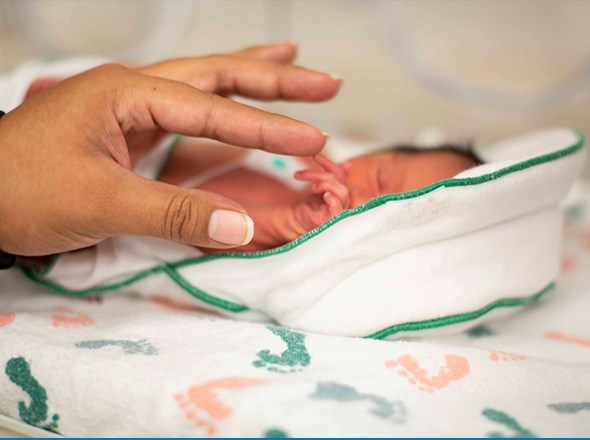Tiny blood pressure cuffs smaller than a sticky note wait in a bin at Texas Health Fort Worth. Another bin is stuffed with knitted caps so tiny they would barely stretch over a baseball. Still more bins here and at other Texas Health hospitals across North Texas hold tiny catheters, tiny pacifiers, impossibly small diapers.
This is the world of neonatal intensive care units, where physicians and nurses care for the tiniest of patients.
It’s a world that is shrinking in a sense, but growing at the same time, as neonatologists care for ever younger and smaller babies, said Dr. Antonio Santiago, a member of the medical staff at Texas Health Plano and medical director of the hospital’s NICU.
Ten years ago, the survival rate for a baby born at 22 weeks’ gestation was only 18-19 percent, he said. The number has increased dramatically – now babies that young have a 34-35 percent chance of survival, he said.
The difference is not in better equipment – Santiago said tiny chest tubes, catheters and other devices used to help a preemie survive have been the same since the 1980s, with the important exception of better ventilation machines. Called high-frequency ventilators and developed in the 1990s, the devices are less traumatic for babies than their conventional counterparts.
Rather than developing different equipment, physicians have refined the processes used with very young babies, learning that in many cases less is more.
For example, simply keeping the room where a C-section will be performed at 72 degrees or higher – not done in the 1970s through the 1990s – increases a premature baby’s chances for survival, Santiago said.
Read more: Texas Health Plano NICU receives top state designation
Delaying the clamping of the umbilical cord by a matter of seconds also makes a big difference, Santiago said.
“We used to think that receiving the baby quickly after delivery was the right way to do it because we would start warming the baby, giving oxygen, providing respiratory support right away,” he said. “But we have learned with time that if you delay the cord clamping — if you let the baby receive cord blood for an extra 30 seconds after being born – they have less complications for the first hours to days of life.”
The benefits are many, he said: fewer problems with blood pressure and glucose instability, fewer brain bleeds, fewer medications needed, fewer blood transfusions for the first two or three days after birth.
“We have, over the years, been less invasive as time goes on,” Santiago said. “Use of surfactant in lungs [to keep air sacs from sticking together] means less use of ventilators, endotracheal tubes and fewer chances of pneumothorax (air leaks in the lungs).”
“We don’t have to invent smaller catheters and smaller this and that because the outcomes and complications we used to see in the ‘80s are less,” he said.
Still, he said if the trend continues toward caring for younger and smaller babies, equipment will have to change for the smallest of the small.
“Because we’re talking about a baby the size of an iPhone,” he said.
Read more: Children’s Health Plano opens orthopedic and sports specialty center
During post-delivery, minute adjustments can make all the difference, said Dede Scholl, manager of the NICU at Texas Health Dallas, who has been caring for preemies for three decades.
Even a baby’s position can affect development. A too-big diaper splays open the legs, affecting hip development. Letting a tiny baby lie with arms spread out to the sides affects shoulder development. Tiny heads can develop flat spots or elongate if left lying in one position for too long.
Moms and dads get used to tininess, too.
“They had tiny nail clippers … tiny pacifiers, tiny bottles once he started eating, all the medical equipment of course was tiny,” remembers Sarah McClellan-Brandt, whose son Gus was born at 27 weeks weighing 2 lbs., 5 oz. “I know we bought some teeny tiny clothes and hats.”
Gus was in a NICU for 95 days. Today, he’s 16 months old and “huge,” McClellan-Brandt said, at 24 pounds.
In contrast, Dr. Santiago’s smallest baby so far in a career that began in 1988 was a “very feisty” 10-ounce girl in 1989, he said, noting that she was smaller than a Coke bottle.
He smiled. “She made it.”
For more information about Texas Health Resources, call 1-877-THR-WELL, or visit www.TexasHealth.org.




